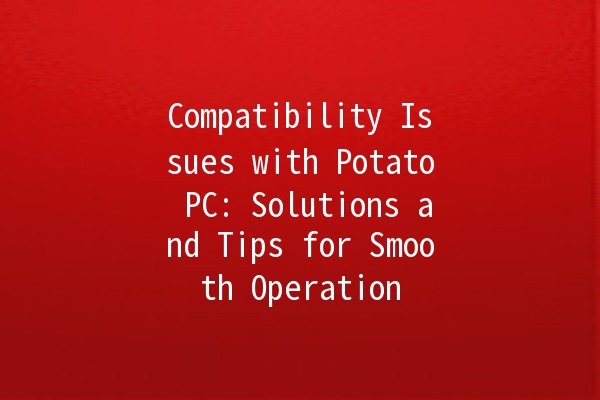Potato PC is gaining popularity among gamers and casual users alike due to its unique ability to run less demanding games and programs on lowend hardware. However, users often face compatibility issues that can hinder their experience. This article will delve into these issues, providing practical advice and tips to maximize productivity while using Potato PC.
Understanding Potato PC Compatibility Issues
Potato PC aims to provide functionality on hardware that typically struggles with modern gaming demands. While this is excellent for light gaming and basic tasks, it often encounters several compatibility hurdles.

Common Compatibility Issues:
Tips for Enhancing Potato PC Performance
To address these compatibility issues, here are five productivity enhancement techniques users can employ.
Description: Adjust your Potato PC’s settings to improve performance.
Example: Navigate to your system settings and disable unnecessary visual effects. In Windows, you can adjust these by searching for "Performance Options" in the Control Panel and selecting "Adjust for best performance". This can free up resources for more critical applications and games.
Description: Ensure that all drivers (especially for GPU) are updated to the latest versions.
Example: Use tools like Device Manager or thirdparty applications such as Driver Booster to scan for outdated drivers. Installing the latest drivers can enhance application compatibility and significantly improve gaming performance.
Description: Run applications or games in compatibility mode to mimic previous versions of the operating system.
Example: Rightclick the application shortcut, select "Properties," go to the "Compatibility" tab, tick the box for "Run this program in compatibility mode," and select an earlier version of Windows. This setting often resolves issues with older games that struggle on newer systems.
Description: Minimized background processes to allocate more resources to the main application being used.
Example: Use the Task Manager (Ctrl + Shift + Esc) to identify and close unnecessary applications running in the background. Look for resourceheavy applications that you do not need, such as web browsers with many tabs open.
Description: Lower the graphics settings in games for smoother gameplay.
Example: When playing a game, go to its settings, select "Graphics," and lower settings such as resolution, texture quality, and draw distances. This adjustment reduces the workload on the CPU and GPU, helping to prevent stuttering or crashing.
Frequently Asked Questions
What should I do if games do not launch on my Potato PC?
Games may not launch for several reasons. Check if your hardware is compatible with the game’s minimum requirements. If everything checks out, try updating your drivers and ensuring that any necessary frameworks, like DirectX or .NET, are installed.
How can I tell if my Potato PC meets the system requirements for a specific game?
Most game developers publish the minimum and recommended requirements on their game pages. Compare these with your Potato PC's specifications, which can usually be found in the System Information tool on Windows.
Why does my Potato PC run slowly when multiple applications are open?
This behavior can be due to limited RAM or CPU power. More applications consume more resources. To alleviate this, close unnecessary applications and consider upgrading your RAM, if the system allows it.
Are there any utilities to enhance performance specific to Potato Pcs?
Yes, several utilities can help optimize your Potato PC. Programs like CCleaner can help manage startup processes and clear temporary files, while MSI Afterburner is ideal for tweaking GPU settings to improve performance.
Can I upgrade components in my Potato PC?
Upgrading components depends on your specific hardware. Many lowend PCs allow RAM upgrades, and some may allow GPU upgrades. Review your PC’s motherboard specifications for compatibility before purchasing new components.
Is it possible to run more demanding games on my Potato PC?
While Potato PCs are not designed for highend gaming, there are ways to run more demanding games at lower settings. Use tools like GeForce Now or cloud gaming services, which allow you to stream games without needing highspec hardware.
By following these techniques and answers, users can effectively mitigate compatibility issues and enjoy a more productive experience on Potato PC. With the right adjustments and considerations, achieving a smooth and enjoyable operation is entirely within reach!